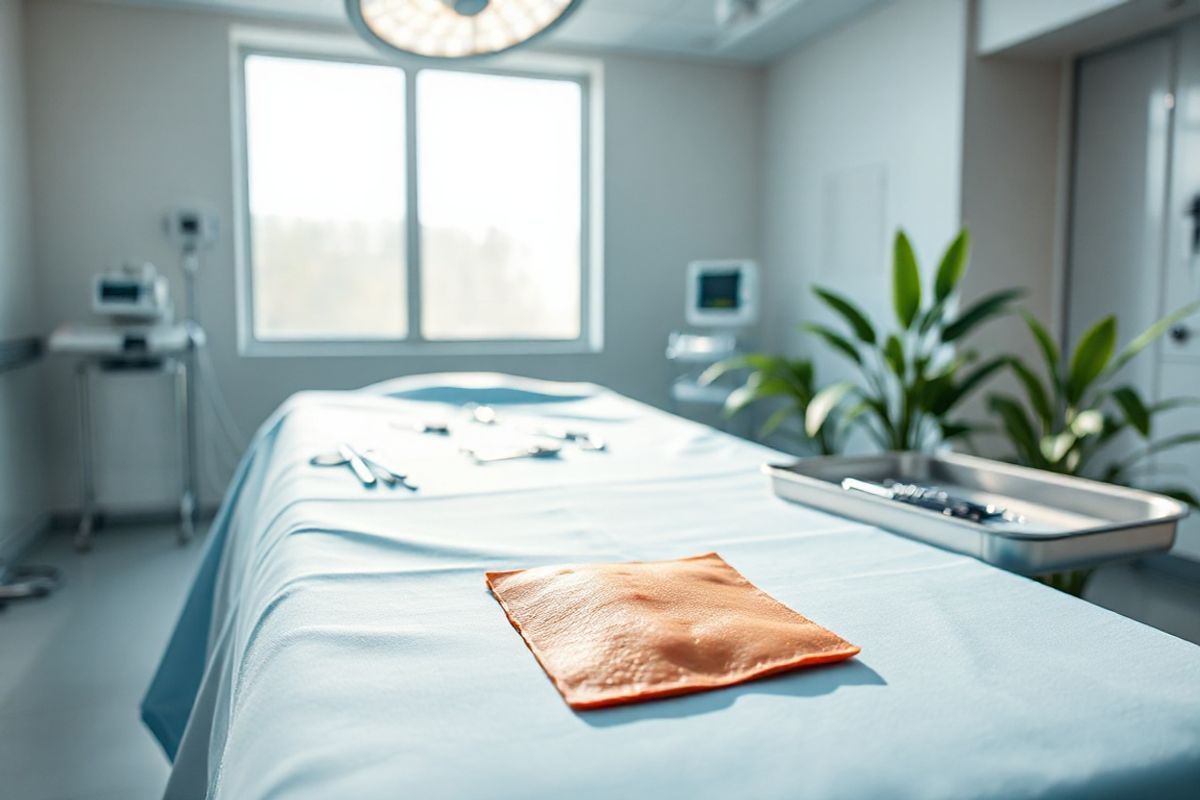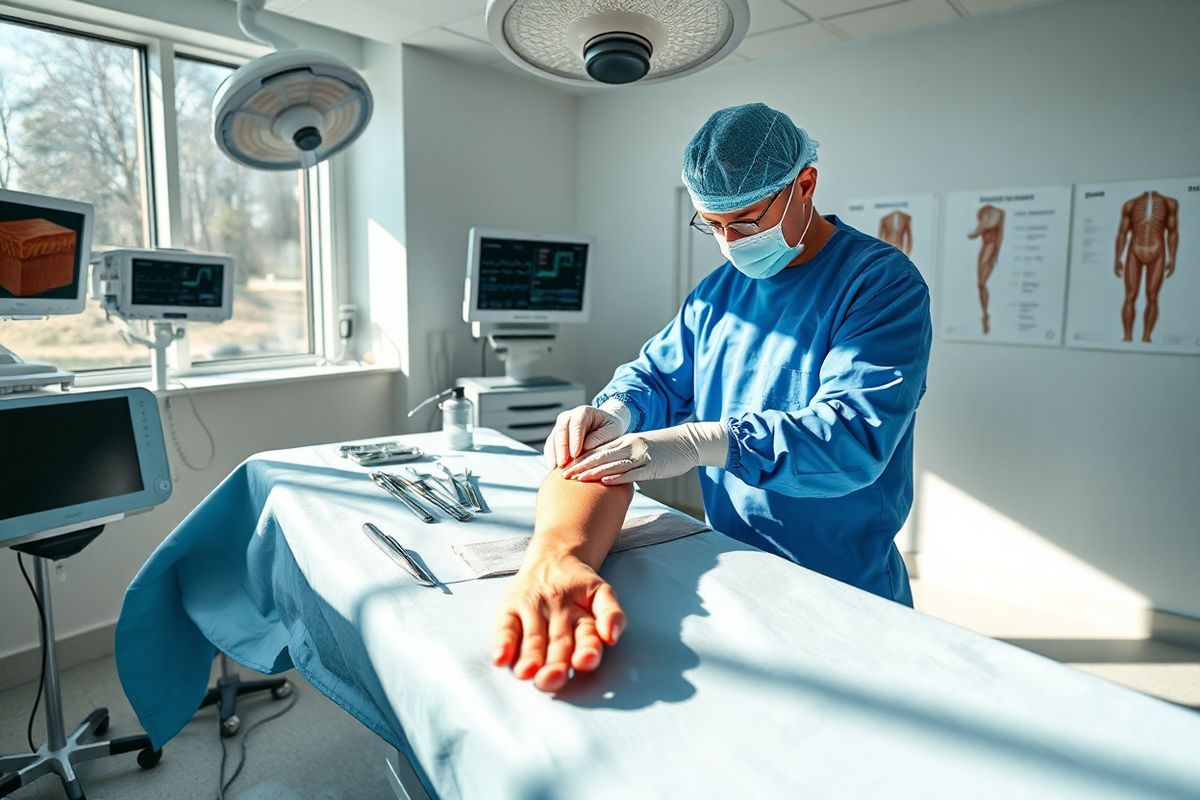Table of Contents
What is a Skin Graft and Why is it Necessary?

A skin graft is a surgical intervention involving the removal and transplantation of healthy skin from one part of the body to another to promote healing of an area with damaged or missing skin. The necessity for skin grafts arises primarily when the skin loss is too extensive to heal by secondary intention—a process where the wound heals naturally without surgical closure. Conditions that often necessitate skin grafting include:
- Burns: Severe burns can destroy skin layers, requiring grafting to restore skin integrity.
- Infections: Skin infections that result in necrosis may necessitate grafting after debridement.
- Ulcers: Chronic wounds, such as diabetic ulcers or venous ulcers, may not heal adequately without grafting.
- Surgical Removal: Procedures like excisions of skin cancer often require skin grafts to cover the resultant defects (Cleveland Clinic, 2023).
Grafts not only facilitate faster healing but also help restore skin function and aesthetics, making them crucial for patient recovery.
The Different Types of Skin Grafts: Choosing the Right Procedure for Optimal Healing

Skin grafts can be categorized into three main types: autografts, allografts, and xenografts, each serving different clinical needs.
-
Autografts: This is the most common type, where the graft is taken from the patient’s body, ensuring the highest compatibility and reduced risk of rejection. Typical donor sites include the inner thigh, abdomen, and back. This procedure is usually preferred for its effectiveness in healing large wounds and minimizing complications (UVA Health, 2023).
-
Allografts: In cases where the patient does not have enough healthy skin available, skin may be sourced from a deceased donor. Allografts serve as temporary coverings and are often used in burn units until the patient can undergo autografting.
-
Xenografts: These grafts involve the use of skin from other species, commonly pigs. Like allografts, they are typically used as temporary measures to protect the wound until a more permanent solution can be implemented.
Types of Skin Grafts by Thickness
-
Split-thickness skin graft (STSG): This involves the removal of the epidermis and a portion of the dermis. It is used for larger areas and is more fragile but promotes faster healing at the donor site (Healthline, 2023).
-
Full-thickness skin graft (FTSG): This graft includes the entire dermis and epidermis, providing better cosmetic results but requiring longer healing times and more careful management post-surgery (Mount Sinai, 2023).
-
Composite graft: This specialized graft includes skin along with other tissues like cartilage, typically used in reconstructive surgeries of the nose or ears.
| Type of Graft | Description | Common Uses |
|---|---|---|
| Autograft | Skin from the same patient | Burns, large wounds |
| Allograft | Skin from a deceased human donor | Temporary coverage for extensive wounds |
| Xenograft | Skin from another species (e.g., pig) | Temporary coverage |
| STSG | Epidermis + part of the dermis | Large areas of skin loss |
| FTSG | Full thickness of skin | Cosmetic repairs, facial surgeries |
Preparing for Skin Graft Surgery: Essential Steps for Successful Outcomes
Proper preparation for skin graft surgery is essential to ensure optimal outcomes. Patients are advised to follow these essential steps:
-
Consultation and Assessment: Prior to the surgery, patients should have a thorough consultation with their surgeon to discuss the procedure, potential risks, and expected outcomes. The surgeon will assess the wound and determine the appropriate type of graft (Cleveland Clinic, 2023).
-
Medication Management: Patients may need to stop taking certain medications, particularly blood thinners, that can affect bleeding and healing. Smoking cessation is highly recommended as smoking can significantly impair wound healing (Healthline, 2023).
-
Nutrition: Ensuring proper nutrition before surgery is vital. A diet rich in protein, vitamins, and minerals will support healing. Patients should discuss dietary plans with their healthcare provider (Mount Sinai, 2023).
-
Hygiene and Skin Preparation: The surgical site should be cleaned thoroughly to minimize the risk of infection. Patients might be instructed to use antiseptic cleansers on the day before surgery.
-
Arranging Post-Surgery Help: It is advisable to have someone available to assist with daily activities post-surgery, as mobility may be limited during the initial healing phase (UVA Health, 2023).
Post-Surgery Care: Ensuring Effective Wound Healing After a Skin Graft
Post-operative care is critical to the success of a skin graft. Patients should adhere to the following guidelines:
-
Dressing Management: The graft site should be covered with a sterile dressing to protect it from infection. Patients must follow their surgeon’s instructions on how long to keep the dressing in place and how to change it safely (Cleveland Clinic, 2023).
-
Monitoring for Signs of Infection: Patients should be vigilant for symptoms such as increased redness, swelling, warmth, or discharge from the graft site. Any signs of infection should be reported to a healthcare provider immediately (Healthline, 2023).
-
Pain Management: Pain relief should be managed according to the healthcare provider’s recommendations. This may include prescribed medications or over-the-counter pain relief (Mount Sinai, 2023).
-
Activity Restrictions: Patients are generally advised to avoid strenuous activities and to keep the graft site as still as possible to promote adherence and healing. Physical activity restrictions typically last for at least three weeks (UVA Health, 2023).
-
Follow-Up Care: Regular follow-up appointments are essential to monitor the healing process. The healthcare provider may recommend physical therapy to improve flexibility and strength in the grafted area (Cleveland Clinic, 2023).
Potential Complications and How to Navigate Them: A Guide for Recovery
While skin grafts are generally safe and effective, they are not without risks. Common complications include:
-
Graft Failure: Sometimes the graft may not take, which can be caused by infection, inadequate blood supply, or excessive movement of the graft. Early signs include a lack of blood vessel growth in the grafted area (Healthline, 2023).
-
Infection: Infection can occur at either the donor or graft site. Strict hygiene and care protocols are critical in minimizing this risk (Mount Sinai, 2023).
-
Scarring: All surgical procedures result in some degree of scarring. The extent can vary based on the type of graft, the location, and individual healing responses (UVA Health, 2023).
-
Contractures: In some cases, the grafted skin may contract as it heals, which could restrict movement, particularly if placed over joints (Cleveland Clinic, 2023).
-
Delayed Healing: Some patients may experience slower healing due to underlying conditions such as diabetes or peripheral vascular disease, which can impede blood flow to the area (Healthline, 2023).
Navigating Complications
To navigate potential complications, patients should maintain open communication with their healthcare providers, attend all follow-up appointments, and adhere strictly to post-operative care instructions. Any concerns about healing, including changes in appearance or sensation of the grafted area, should be discussed with a medical professional promptly.
FAQ Section
How long does it take for a skin graft to heal?
The healing time for a skin graft can vary, but typically it takes about 2 to 3 weeks for the graft site to begin showing signs of healing, with full recovery potentially taking several months.
Can I go back to normal activities after a skin graft?
It’s essential to avoid strenuous activities for at least three weeks post-surgery, but your healthcare provider will give you specific guidelines based on your situation.
What should I look for in terms of complications after a skin graft?
Be vigilant for signs of infection such as increased redness, swelling, or discharge. Additionally, monitor for any unusual changes in the appearance of the graft.
Is there anything I can do to improve my healing after a skin graft?
Yes, maintaining a healthy diet rich in vitamins and protein, staying hydrated, and following your healthcare provider’s instructions for care can enhance healing.
Will I have scarring after a skin graft?
Yes, all grafts leave some degree of scarring. The extent can depend on various factors, including the type of graft and individual healing processes.
References
-
Cleveland Clinic. (2023). Skin Graft: What Is It, Risks, Benefits & Recovery. Retrieved from https://my.clevelandclinic.org/health/treatments/21647-skin-graft
-
UVA Health. (2023). Skin Graft. Retrieved from https://uvahealth.com/services/plastic-surgery/skin-graft
-
Healthline. (2023). Skin Graft: Purpose, Types, and Procedure. Retrieved from https://www.healthline.com/health/skin-graft
-
Mount Sinai. (2023). Skin graft Information. Retrieved from https://www.mountsinai.org/health-library/surgery/skin-graft











